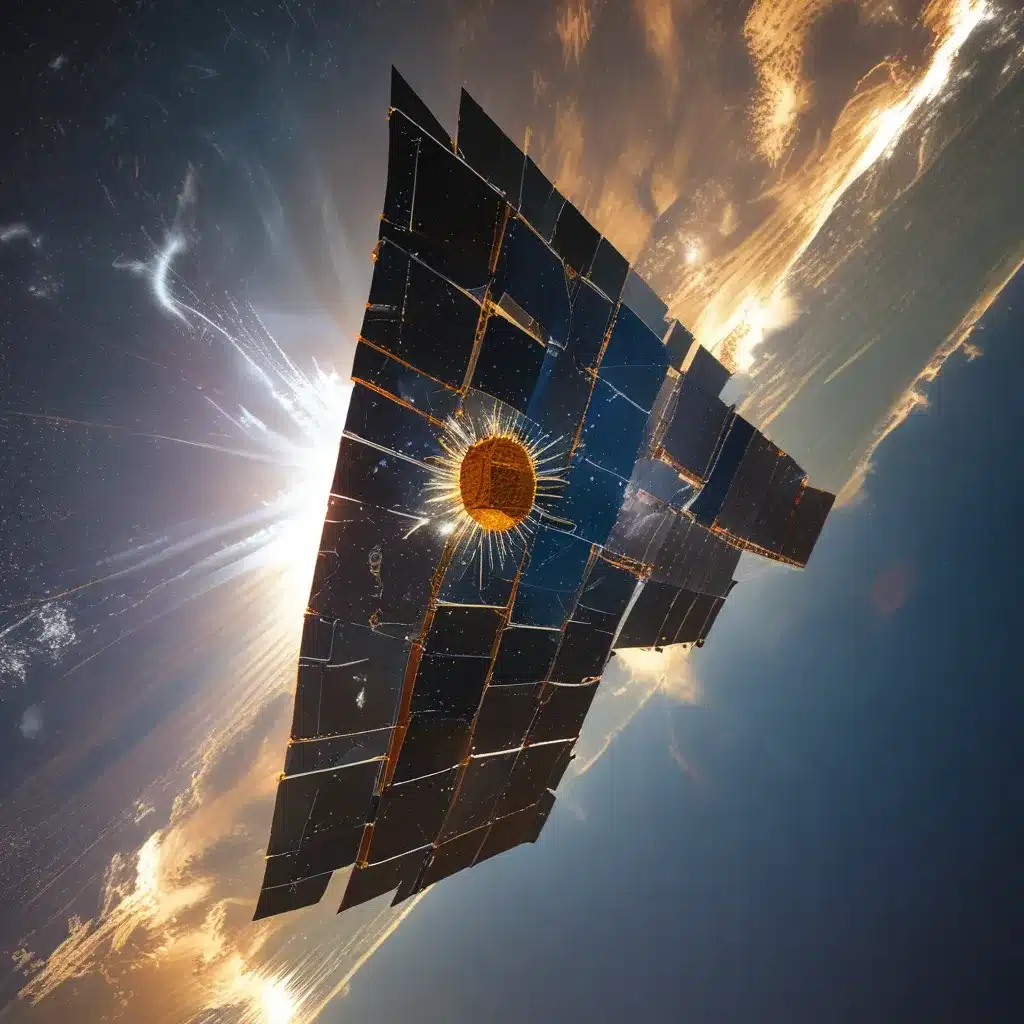
Harnessing the Sun’s Endless Bounty from Above
I must admit, when I first heard about the idea of harvesting solar power from space, I couldn’t help but feel a bit like I was living in a sci-fi movie. Orbiting solar power stations beaming clean, limitless energy down to Earth? It sounded like the kind of fantastical concept you’d see in a futuristic blockbuster, not something that could actually become a reality. But let me tell you, my friends – the future is now. Solar power satellites are no longer just the stuff of imagination.
As The Week recently reported, the UK government has just given the green light to a £43 million project to develop a “Bond-style floating solar power station” that could supply up to a quarter of the country’s electricity. And this is just the tip of the iceberg. Around the world, scientists and engineers are making remarkable breakthroughs that are turning this once pie-in-the-sky idea into a viable, game-changing solution for our planet’s energy needs.
The Endless Potential of Space-Based Solar Power
So, what exactly is space-based solar power, and why is it such a big deal? The basic concept is pretty straightforward: by placing solar panels in orbit, we can harvest the sun’s energy 24/7, without any of the pesky impediments that limit ground-based solar, like cloudy skies, nighttime, or seasonal variations. As The Week explains, this could potentially yield up to eight times more power than terrestrial solar panels.
Just imagine the implications. No longer would we be at the mercy of the weather or the rotation of the Earth. Instead, we’d have access to a virtually limitless supply of clean, renewable energy, beamed down to us from above. It’s the kind of game-changing innovation that could revolutionize the way we power our homes, our businesses, and our entire civilization.
And the best part? The technology is finally catching up to the vision. As The Week reports, a recent experiment by the California Institute of Technology (Caltech) has successfully demonstrated the viability of wirelessly transmitting power from space to Earth. It’s a major milestone that’s breathing new life into this long-dreamed-of concept.
The Race to Harness the Sun’s Might from Orbit
Of course, this isn’t the first time someone has dreamed of tapping into the sun’s endless bounty from above. As the University of California, Santa Barbara explains, the idea of space-based solar power has been around since the dawn of the space age. Back in the 1950s, the “father of astronautics,” Konstantin Tsiolkovsky, envisioned vast orbital power stations that could beam energy back to Earth.
But for decades, the technological and logistical challenges of such an ambitious endeavor proved insurmountable. Launching the massive, specialized equipment required into orbit was prohibitively expensive, and the engineering feats necessary to wirelessly transmit power from space seemed like the stuff of science fiction.
That’s all starting to change now, though. With the rise of reusable rockets and ever-improving solar panel and microwave transmission technologies, the barriers to making space-based solar power a reality are tumbling down. As one expert told The Week, “There may be a pathway to make this reality.”
The Race to the Skies
And it’s not just the UK that’s racing to harness the sun’s power from above. The Week reports that the China Academy of Space Technology has announced plans for a similar system by 2028, while military labs in the US are reportedly experimenting with technologies that could beam power to remote bases or even combat zones.
Meanwhile, the European Space Agency (ESA) is considering a project called Solaris, which aims to build commercial power stations in orbit. And as science fiction author Allen Steele told Lightspeed Magazine, the race to harness the sun’s power from space is heating up, with various nations vying to be the first to make this dream a reality.
It’s an exciting time, to be sure. But as The Week points out, significant challenges remain. Transmitting gigawatts of power wirelessly to Earth will require massive antenna farms, and there are concerns about the potential health and security implications. Not to mention the question of how much customers will have to pay for this space-based solar electricity.
The Future is Bright (and Affordable)
Still, the experts seem optimistic. As one Caltech engineer told The Wall Street Journal, “There is an existential need for abundant clean power, and this could help get us there.” And with the cost of launching equipment into orbit dropping rapidly, the financial barriers may not be as daunting as they once were.
In fact, according to The Week, one expert believes that power from space could soon become a cost-competitive renewable technology, potentially even cheaper than coal. Imagine that – clean, limitless energy, beamed down from the heavens, for less than the dirty, finite fossil fuels we’ve been relying on for generations.
It’s the kind of future that, not too long ago, would have seemed like pure science fiction. But as UK Energy Secretary Grant Shapps said, “People thought it was impossible to land a man on the Moon or impossible to split that atom. You follow the science and the impossible becomes possible.”
And that’s precisely what’s happening with space-based solar power. The impossible is becoming possible, and the future of our planet’s energy landscape is about to get a whole lot brighter. Who knows, maybe one day we’ll look back on this moment and laugh at how naive we were to ever doubt the potential of harnessing the sun’s power from above.
In the meantime, I can’t wait to see what the pioneering teams at Solar Systems Inc. and other innovators around the world are able to accomplish. The race to the skies is on, and the future of renewable energy has never looked more promising. Buckle up, my friends – this is going to be one heck of a ride.


